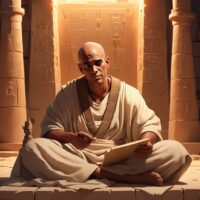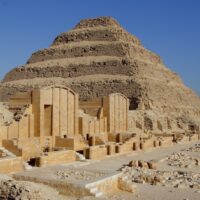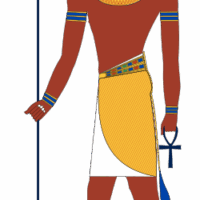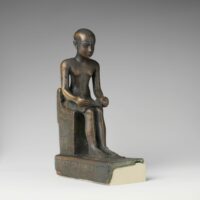Imhotep : The Genius Architect
Listen
At a glance
| Description | |
|---|---|
| Origin | Egyptian Mythology |
| Classification | Mortals |
| Family Members | Kanofer (Father), Khereduankh (Mother) |
| Region | Egypt |
| Associated With | Intelligence, Architecture |
Imhotep
Introduction
Imhotep, meaning “He Who Comes in Peace,” is one of the most remarkable individuals from ancient Egypt, whose life and legacy stretch beyond time and discipline. Living during Egypt’s Third Dynasty (circa 27th century BCE), he served as vizier to Pharaoh Djoser and is widely acknowledged as the visionary behind the Step Pyramid at Saqqara—the earliest large-scale stone structure ever constructed. His brilliance extended far beyond architecture. He was also a priest, physician, scribe, and astronomer. Over time, Imhotep transitioned from a respected historical figure to a mythologized icon and eventually a deified being revered as the god of healing. His story bridges the domains of fact, legend, and cultural memory, influencing everything from ancient temple rituals to modern science.
Physical Traits
While no contemporary images of Imhotep from his lifetime survive, subsequent artistic renditions from later periods show him seated in a dignified posture, typically holding a scroll of papyrus. These portrayals emphasize intellect and scholarship rather than divine spectacle or royal grandeur. He is almost always bald, dressed in a modest robe, and shown as a man of serene contemplation—an embodiment of quiet mastery rather than flamboyant power. Unlike depictions of other gods or rulers adorned in opulence, Imhotep’s imagery focuses on humility and intelligence, highlighting his identity as a thinker and healer rather than a warrior or monarch. These artistic choices underscore how his wisdom was his most revered trait.
Family
Imhotep’s familial lineage is somewhat mysterious, blending myth and tradition. In ancient Egyptian belief, he was sometimes regarded as the son of the creator god Ptah, making him part of a divine framework. His human mother, Khereduankh, was later elevated in status and occasionally worshipped alongside him. These divine associations became more prominent as his cult grew, particularly in the Late Period and into the Greco-Roman era, when religious syncretism led to further mythologization. Despite the lack of definitive records about a spouse or children, Imhotep’s symbolic “family” included other deities, with some myths describing him as the brother of Thoth or Nefertem. These connections positioned him within Egypt’s theological structure, solidifying his place as a spiritual bridge between gods and humanity.
Other names
Over the centuries, Imhotep became known by a variety of names and honorifics, reflecting the breadth of his influence across cultures and epochs. In Egyptian inscriptions, his name was rendered as “ỉỉ-m-ḥtp,” which translates directly to “he who comes in peace.” In Greek sources, he was referred to as Imouthes, a Hellenized version of his name used during the Ptolemaic and Roman periods when his cult saw renewed interest. As his healing reputation flourished, he was equated with the Greek god Asclepius, the god of medicine, further cementing his status in the Mediterranean world. Titles like “Son of Ptah” and “Great of Magic” were common epithets, underscoring his connection to divine creation and spiritual power.
Powers and Abilities
Imhotep’s abilities were both real and imagined, with historical achievements evolving into mythological powers over the centuries. Historically, he was a polymath of immense capability. His architectural feats, especially the Step Pyramid, revolutionized Egyptian construction and introduced the use of stone as a primary building material. His medical knowledge was so profound that later generations credited him with writing texts like the Edwin Smith Papyrus, which displays an understanding of injuries and surgical techniques rarely seen in antiquity.
As his legend grew, Imhotep became a divine figure endowed with supernatural skills. He was worshipped as a healer whose divine insight allowed him to cure ailments and reveal remedies in dreams. Shrines dedicated to him became pilgrimage sites for the sick, who sought healing through prayer and ritual. Mythic narratives gave him broader powers—some accounts describe him possessing magical abilities, commanding elements, or even restoring life. Popular culture further amplified these powers, portraying him in films as a sorcerer capable of controlling plagues, summoning sandstorms, and regenerating after death. These portrayals, while fictional, reflect his enduring mystique and the deep reverence for his ancient persona.
Modern Day Influence
Imhotep’s influence continues to resonate in various dimensions of modern society, ranging from education and medicine to architecture and pop culture. He is frequently referred to as the world’s first known physician, predating Hippocrates by more than two millennia. His holistic approach to medicine—observing symptoms, applying reason, and maintaining bodily balance—set a foundation for later medical traditions. In the field of architecture, his pioneering work on the Step Pyramid remains a touchstone for innovation, planning, and the integration of aesthetic with function.
In contemporary times, institutions and initiatives bear his name to inspire excellence in science, engineering, and healthcare. One notable example is Imhotep’s Legacy Academy in Canada, designed to support Black and Indigenous students in pursuing STEM careers. His name symbolizes knowledge, discipline, and innovation, serving as a role model across disciplines.
In the realm of entertainment, Imhotep has been reimagined in novels, games, and films. The 1999 movie The Mummy introduced him to a new generation, albeit as a villainous character loosely based on the historical figure. Despite these fictional liberties, the film rekindled interest in his story and Egypt’s broader mythology. His character has since become a symbol of ancient wisdom intertwined with mystery and magic.
Imhotep’s presence is also felt in philosophical and spiritual dialogues, where he’s often cited as a symbol of balance between intellect and divine insight. His integration of architectural genius, medical knowledge, and spiritual leadership exemplifies the ancient Egyptian ideal of maat—the harmony of the universe.
Related Images
Source
Britannica. (2025). Imhotep. Retrieved from https://www.britannica.com/biography/Imhotep
Wikipedia contributors. (2025). Imhotep. Wikipedia. Retrieved from https://en.wikipedia.org/wiki/Imhotep
Mark, J. J. (2016). Imhotep. World History Encyclopedia. Retrieved from https://www.worldhistory.org/imhotep/
Powell, L. (2025). The Celestial Architect: Imhotep and the Order of the Universe. Egypt Mythology. Retrieved from https://egyptmythology.com/the-celestial-architect-imhotep-and-the-order-of-the-universe/
Ancient Egyptian Facts. (2025). Imhotep: The First Architect. Retrieved from https://ancientegyptianfacts.com/imhotep-the-first-architect.html
Unimed Living. (2025). Imhotep – The Father of modern medicine. Retrieved from https://www.unimedliving.com/ageless-wisdom/the-lineage/imhotep.html
Frequently Asked Questions
What is lorem Ipsum?
I am text block. Click edit button to change this text. Lorem ipsum dolor sit amet, consectetur adipiscing elit. Ut elit tellus, luctus nec ullamcorper mattis, pulvinar dapibus leo.
What is lorem Ipsum?
I am text block. Click edit button to change this text. Lorem ipsum dolor sit amet, consectetur adipiscing elit. Ut elit tellus, luctus nec ullamcorper mattis, pulvinar dapibus leo.
What is lorem Ipsum?
I am text block. Click edit button to change this text. Lorem ipsum dolor sit amet, consectetur adipiscing elit. Ut elit tellus, luctus nec ullamcorper mattis, pulvinar dapibus leo.
What is lorem Ipsum?
I am text block. Click edit button to change this text. Lorem ipsum dolor sit amet, consectetur adipiscing elit. Ut elit tellus, luctus nec ullamcorper mattis, pulvinar dapibus leo.
What is lorem Ipsum?
I am text block. Click edit button to change this text. Lorem ipsum dolor sit amet, consectetur adipiscing elit. Ut elit tellus, luctus nec ullamcorper mattis, pulvinar dapibus leo.










